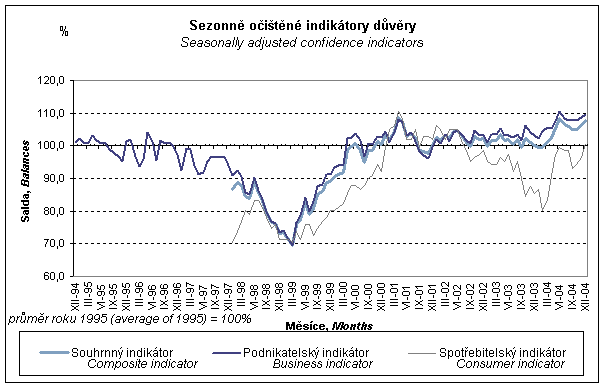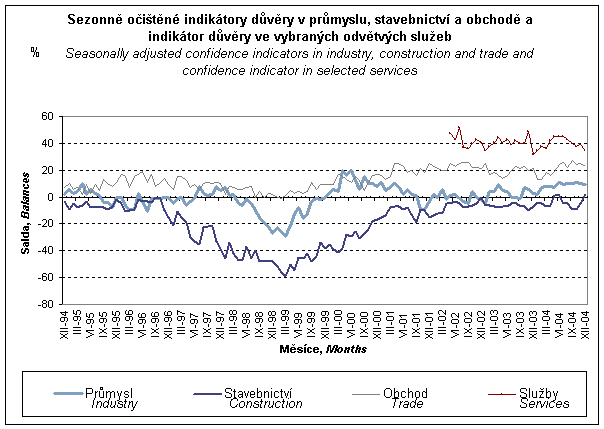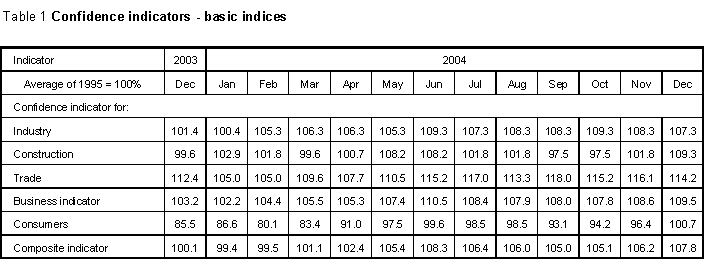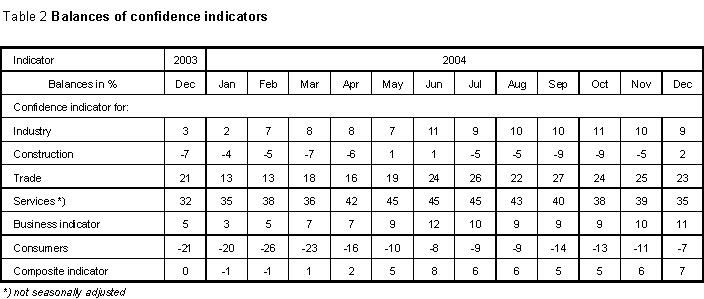Business cycle survey - December 2004
High confidence of both entrepreneurs and consumers
Publication Date: 28. 12. 2004
Product Code: r-1201-04
The composite confidence indicator balance increased in December 2004 compared to the previous month, which was caused by increases in both the business confidence indicator balance, especially in construction, and the consumer confidence indicator balance. Compared to December 2003, the business confidence indicator increased by 6 points, the consumer confidence indicator by 14 points and the composite confidence indicator by 7 points.

In industry (940 respondents), 47% of the respondents considered their economic situation in December good, 50% satisfactory and 3% bad, which is a better result than in November. After seasonal adjustment, the assessment of current total demand (order books) for enterprise output increased compared to the assessment in November (balance 1 point up). The assessment of current foreign demand also improved (balance 2 points up). Stocks of finished goods did not change, the respondents say.
In next three months, the respondents expect the production activity to slacken (balance 5 points down) and the employment to improve (balance 4 points up). In next six months , they expect their economic situation to get worse. All the data are seasonally adjusted.
On the whole, the confidence indicator in industry decreased by 1 point month-on-month. Compared year-on-year, the indicator is by 6 points up on December 2003. It still reaches high values in the long run.
The investment activity survey has been conducted second time this year. The survey suggests that investment in 2005 is expected to grow in manufacturing (by 10%), the main factors influencing the respondents’ investment decisions being demand and financial resources. The investment should mainly go renewal and extension of existing capacities and construction of new ones.
In construction enterprises (546 respondents), the assessment of the current economic situation (after seasonal adjustment) in December remains still favourable as in November. The assessment of current total demand (order books) for enterprise output increased (balance 12 points up). In next three months , the respondents expect the construction activity to grow (balance 8 points up) with the employment rising, too (balance 3 points up) – all seasonally adjusted. Generally, the confidence indicator in construction increased by 7 points month-on-month. Year-on-year, it is 9 points up.
Of respondents engaged in trade (314 respondents), 49% considered the economic situation of their enterprises in December good, 48% as corresponding to the season and 3% bad. Month-on-month, this translates into no change in the balance. All in all, trade increased its stock of inventories (seasonally adjusted). 78% of the respondents expect unchanged price development, while 7% expect prices to grow and 15% to drop. In next six months , 41% of the respondents predict improvement in the economic situation (39% in November), 57% anticipate no changes (58% in November) and 2% expect worsening (3% in November). The overall confidence indicator in trade decreased by 2 points month-on-month, but it was still 2 points up year-on-year.
In selected branches of services (736 respondents), 59% of the respondents assessed their current economic situation in December as good, 40% as corresponding to the season and 1% as bad, which was a slightly worse assessment than in November. 28% of the respondents expect the demand to rise (order books), while 63% anticipate no changes, and 9% think that the demand will decrease – and these expectations are worse than in November. According to 85% of the respondents, no changes in price development should occur, 14% envisage a rise in prices and 1% a drop. The number of employees is expected to decrease (29% of the respondents), remain unchanged (60%) or increase (11%). The overall confidence indicator in selected branches of services decreased. Compared to December 2003, the indicator is 3 points up.

The survey taken among consumers (1000 respondents) in December suggests an increase in the balance of the indicator of expected overall economic situation (+6 points) and no changes in the balance of their financial situation in next twelve months . Compared to November 2004, the percentage of consumers expecting higher unemployment decreased (balance 7 points down). The percentage of the respondents going to save money increased (balance 3 points up). The overall consumer confidence indicator increased both month-on-month (4 points up) and year-on-year (14 points up).


Note
Contact: Marie Hörmannová, phone (+420) 274052049,
e-mail hormannova@gw.czso.cz
Data source: CZSO business surveys, GfK Praha consumer survey
End of data collection: 20 December 2004
End of data processing: 23 December 2004
For more information see: https://csu.gov.cz
Methodological explanatory notes :
The composite confidence indicator is a weighted average of seasonally adjusted confidence indicators in industry, construction, trade, and of the consumer confidence indicator. The composite business confidence indicator is a weighted average of seasonally adjusted confidence indicators in industry, construction and trade. The confidence indicator in industry has a double weight. Since January 2002, the consumer confidence indicator has been composed of four indicators (expected financial situation of consumers, expected total economic situation, expected total unemployment (with inverted sign) and savings expected in 12 months to come). Since January 2003, the confidence indicators have been presented as basic indices; the base being the average of 1995.
The branch confidence indicators are constructed as averages of seasonally adjusted weighted business cycle balances. The business cycle balance is the percentage difference between the responses “growth (+)” and “fall (-)”. The confidence indicator for industry is the average of seasonally adjusted balances of three indicators (the assessment of total demand, stocks of final production (with inverted sign) and the expected development of production activity). The confidence indicator for construction is the average of two indicators (the assessment of total demand and the expected development of employment). The confidence indicator for trade is the average of three indicators (the assessment of economic situation, stocks (with inverted sign) and the expected development of economic situation). The business cycle survey in selected services has been conducted by the CZSO since May 2002. This is why the time series are not seasonally adjusted. Data for hotels and restaurants are included in selected services. The time series are converted and the data are comparable. The confidence indicator for selected services is the average of three indicators (the assessment of economic situation, the assessment of demand and expected demand). The confidence indicator for selected services is not being included into composite indicators, yet.
The data above were derived in a weighted manner: sales were used as weights for industry, services and trade, whereas construction work of contractors and subcontractors was the weight for construction. The responding groups of enterprises account for more than a half of sales (industry) and volume (construction) and for a quarter of sales in trade.
